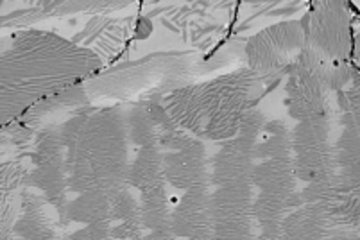All genres
1261.
Talk
Designing novel high-entropy alloys towards superior properties. Frontiers in Materials Processing Applications, Research and Technology (FiMPART'2017), Bordeaux, France (2017)
1262.
Talk
Seeing Hydrogen. 2017 Hydrogen Metal Systems Gordon Research Conference, Stonehill College, Easton, MA, USA (2017)
1263.
Talk
Multiprobe and Multiscale Characterisation of complex Materials. Fraunhofer Conference ‘The Future of Materials – Materials Future‘, Halle, Germany (2017)
1264.
Talk
An integrated crystal plasticity-phase field approach to locally predict twin formation in magnesium. DGM Meeting, "Herausforderungen bei der skalenübergreifenden Modellierung von Werkstoffen ", Regensburg, Germany (2017)
1265.
Talk
Reconstructing field ion microscopy and atom probe data. Australian Atom Probe Workshop, Magnetic Island, Australia (2017)
1266.
Talk
Thermo mechanically coupled simulation of high manganese TRIP/TWIP Steel. 5th International Conference on Material Modeling, ICMM 5, Rome, Italy (2017)
1267.
Talk
Correlated and simulated electron microscopy and atom probe tomography. Workshop on Possibilities and Limitations of Quantitative Materials Modeling and Characterization 2017, Bernkastel, Germany (2017)
1268.
Talk
Crystal Plasticity Simulations on Real Data: Towards Highly Resolved 3D Microstructures. MRS Spring Meeting 2017, Phoenix, Arizona, USA (2017)
1269.
Talk
Predicting Materials Strength in BCC Alloys using parameter-less mesoscale approaches. MRS Spring Meeting 2017, Phoenix, AZ, USA (2017)
1270.
Talk
A Brief History of Metals. Public Named Max Planck Lecture, MPIE Düsseldorf, Düsseldorf, Germany (2017)
1271.
Talk
Ab-initio study of the interplay of hydrogen and microstructure in Ni-based superalloys. DPG 2017, Dresden, Germany (2017)
1272.
Talk
Advanced Atom Probe Tomography. 25th Annual Meeting of the German Crystallographic Society, Karlsruhe, Germany (2017)
1273.
Talk
Atomic Scale Characterization of Complex Materials. Physikalisches Kolloquium, Fakultät für Mathematik und Physik, Universität Freiburg, Freiburg, Ger,amy (2017)
1274.
Talk
Precipitation kinetics during non-linear heat treatment in Laser Additive Manufacturing. ThermoCalc User Meeting 2017, Aachen, Germany (2017)
1275.
Talk
Interfaces and defect composition at the near-atomic scale. MRS Fall Meeting 2017, Boston, MA, USA (2017)
1276.
Talk
Revisiting Field Ion Microscopy. TMS 2017, San Diego, CA, USA (2017)
1277.
Talk
Designing a novel Maraging steel for Laser Metal Deposition exploiting Intrinsic Heat Treatment. Advances in Materials & Processing: Challenges & Opportunities (AMPCO17), Roorkee, India (2017)
1278.
Talk
New insights in the atomic interface structure of kappa carbides in high-Mn steels. TMS2017, San Diego, CA, USA (2017)
1279.
Talk
Deformation Induced Martensite: A Thermodynamic Study. TMS 2017, San Diego, CA, USA (2017)
1280.
Talk
Degradation Mechanism of Molds for Precision Glass Molding. Microscopy & Microanalysis 2017 Conference, St. Louis, MO, USA (2017)











